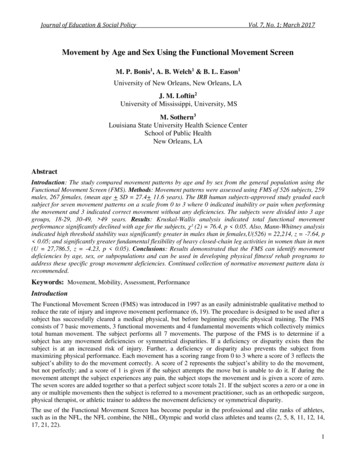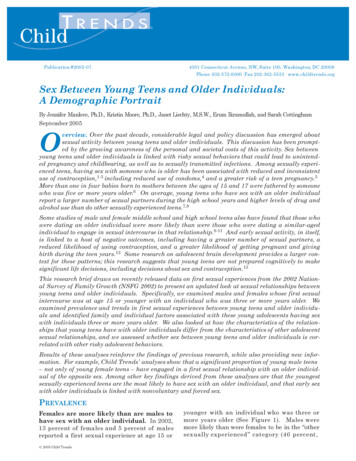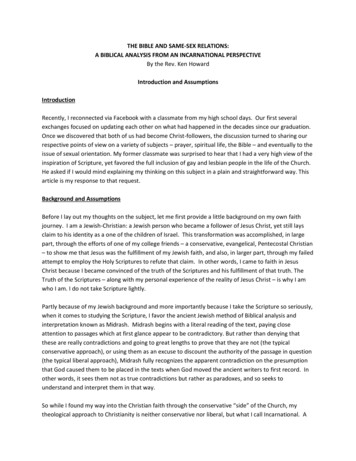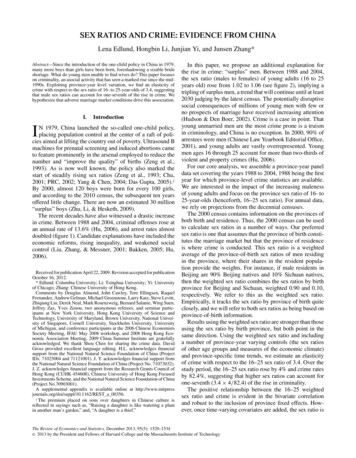
Transcription
“Sex and Lots of Erotic Art to Prove It:The Erotic art of Pompeii”By:Heath WellmanSenior Seminar: HST 499Professor John L. RectorWestern Oregon UniversityMay 28, 2003Readers:Dr. Benedict LoweDr. Emily PlecCopyright Heath Wellman, 20031
The ancient Roman City of Pompeii is a spectacle of some of the worlds mostbeautiful and risqué forms of artwork ever found from ancient ruins. It is a city ofbeautiful villas, streets, bakeries, mansions, coliseums, bars and brothels. But the artworkof Pompeii is not like others found around the world. Rather the artwork from the city ofPompeii is very erotic. The city of Pompeii holds many secrets regarding the ideas ofRoman morality, the erotic frescoes that line entire rooms with depictions of orgies,fellatio and cunnillingus sexual positions, and many other erotic depictions. Depictions inPeristyle Gardens (a colonnaded courtyard) show beautiful frescoes of Pygmies at abanquet being entertained by male and female pygmies having sex in front of the rest ofthe banquet. What does this depiction mean?Figure 1: Pygmy erotic scene from House of the Physician (Clarke, 44)It seems amazing to think that depictions of such things would line the walls of houses ofelite men and women while also being very visible in the public sectors of the town as2
well. It seemed that sexual behavior was appropriate and open in Pompeii. But was itreally?The questions of Roman morality and their obsessive love for erotic art,and its uses in everyday Roman life is the question that I would like to answer in thispaper. I would like to discover the purpose of this art, and why it was placed in bothprivate and public sectors of the city? Lastly, I would like to further understand thereasons why Roman society in Pompeii had such a fetish for erotic art. By understandingthese questions we can begin to understand the personalities and lifestyles of the Romancitizens of Pompeii.How can depictions of male and females having sex at public bathhouses beallowed in the public eye of families, and children especially? Did they have any moralguilt of having such artwork in public and private places of the city? Could there be apossibility that in public areas of the city such depictions at bathhouses would be actedout for pleasure, entertainment, and fun? Where the painting’s clues to the pleasures ofthe owner of the house? Could all this lovemaking have been really displayed all over thetown in such ways, or are these depictions just the art of the Roman world and nothingmore?To answer these questions just discussed, I think that it is important to first to takea look at what different scholars have said about their own research regarding this topic.And then I would like to focus the later part of this paper on the social functions of eroticart in both the private and public sectors of the city. By looking at the two areas of thecity, we will begin to see the use of erotic art, while also evaluating the differencesbetween erotic art and their functions in private and public life.3
There have been many ideas in the archeological and historical communityregarding the ideas about the social sex life of Romans in Pompeii. The research of manyscholars has allowed us to better understand the life of these people. Because the city ofPompeii, Herculaneum and Stabiae were preserved by the ash so well, archeologists andsocial scientist have had the ability to investigate and try to understand this erotic fetishof the Roman people. One of the leading figures in this field would be Michael Grant,who has written several books on the city of Pompeii.One such book is ‘Cities of Vesuvius.’ Grant describes the city of Pompeii as ahaven of prostitution, brothels and bars. But surrounded by elite men and women withfantastic homes, slaves, and all the luxuries of ancient life. But Grant questions many ofthe ideals of Pompeii, mainly the brothels, prostitutes, and bars of graffiti and frescoes.Grant comes to the conclusion that such activities must have taken place, for the liferepresented in the graffiti and art of Pompeii, matches very similarly with the story of theSatyricon. Leaving Grant and other researchers to believe that Pompeii life may havebeen as erotic as depicted in its paintings.John R. Clarke takes the studies of Grant farther by looking closely into theactions of the erotic art of Pompeii, and deciphering their visual rhetoric as an image ofart and love. Clarke shows many examples of Frescoes, jewelry, furniture and other partsof material objects of Roman life that show the eroticism of this society. How depictionsshow rank in society, and status by lovemaking. “What emerges, first and foremost, isthat –contrary to our expectations – the Romans are not at all like us in their sexuality.4
The acts that artists depicted are familiar to us, but the meaning that these representationshad for the viewer are far from the ones we would like to superimpose on them. 1”One of the major issues we have to investigate is the idea of Roman morality andhow it has played into this highly erotic society. It seems that morals and religion musthave played a factor in some way or another in Roman life, and Amy Richlin discussesthis in her book; ‘Pornography and Representation in Greece and Rome.’ Richlin givesus an idea of the morals and also religious beliefs of the Roman system. Her conclusionis that there is a strong interrelation between lovemaking and life in the Roman art.Those morals of the time were much different than they are today. Richlin’s work is agood way to understand the fundamental aspects of sexual concerns regarding morals inthe Roman cities, especially Pompeii.We often times think of the act of love as something that is done in the privacy ofour own homes. It seems very immoral to have public displays of sexual affection,especially in public places that are filled with people. But from the depictions that wecan see in much of the erotic art and graffiti around Pompeii, it seems that sexual acts ofall kinds in the public were a very common and highly accepted part of the Roman life.In the book ‘Eroticism in Pompeii’ by Antonio Varone, he discusses one of theseforms of public erotic behavior that would take place in the theatre of Pompeii. It isimportant to recognize the sexual acts that occurred in the theatre because this will helpus understand the openness of sexual promiscuity between citizens of Pompeii.It seems that often times sexual acts were very much apart of the plays, and thatthe actors would usually play there roles all the way to the end. “The favorite place forsuch moments of lustful eroticism was the theatre genre in which sexual allusion1Clarke, 35
played a substantial and conspicuous part. Sexual acts were often mimed on stage, andsometimes the players forged ahead and completed the act. 2”How did the crowd react to this kind of acting that was taking place? It seemsimmoral to think that sexual acts could have begun in the crowd as well. It seems likelythat sexual promiscuity may have played a role in what was occurring off stage just asmuch as on stage. “Augustus, in his moralizing anxiety, sought to contain thisphenomenon by having the women sit in separate sections of the theatre to keep theirinvolvement from becoming a show within a show. 3”So why was it that public sexual acts would erupt during the play? Were thesesexual acts supposed to be apart of the play itself? Maybe this says something about thetheatre. The theatre can be interpreted as places were the audience can live the story ofthe play. Be apart of the characters of the play and incorporate themselves in the actionthat is taking place. If we look back at what was earlier said by John Clarke, that sexualacts on the stage were most likely not used to arouse the crowd at the theatre, but ratherwas apart of the satirical and funny parts of the play. The idea of mimes, actors anddancers in the act of sex and the truthfulness of their actions was looked at as morecomical than sexual.If my conclusion is true, and the erotic acts being displayed on the stage wereonly for laughs and entertainment and did not produce sexual acts in the crowd, then whywould Augustus create laws to separate the men and women from the theatres? Could itbe that upper elite’s felt that such behavior demoralized the Roman people and madethem seem uneducated and barbaric?23Varone, 49Varone, 496
Otto Kiefer discusses this point in his book ‘Sexual Life in Ancient Rome,’ whichthe actors of the play would end the play depending on the reactions of the crowd. Oftentimes the crowd would seek sexual acts at the end, which was appreciated by the upperclass, but because sexual acts would often seep into the crowd, this demoralized the arton stage, and this is what frustrated the upper class. This may be the reason thatAugustus felt it was necessary to segregate the theatre from the opposite sex.“The pantomimic performances did not necessarily aim at producing purelyerotic effects. The effect desired was rather the imitation and reproductions of everyconceivable emotion by movements of the hands, the arms, the head, and the wholebody; However, in the end the subjects of the pantomimic performances altered – asalways – in accordance with the desires of the public. As we saw above, high officialsand noble ladies did not in the leas object to witnessing the mimic performances ofamazingly erotic scenes: it is easily, therefore, to imagine the development of tasteamongst the uneducated masses 4”These ideas supplied by Kiefer give us another idea of the possibilities of thingsthat could have happened at the theatre. And while I agree that erotic scenes may havecaused some people in the crowd to become excited, it seems more likely that sexualactivities in the crowd were possible to take place, but not a common factor at everyshow. It would be very unrealistic to believe that the sexual acts on stage would erupt thecrowd into mass orgies, but may have played a factor in the other erotic places of the cityafter the performance.The bathhouses of Pompeii could be one place where sexual acts may have beenacted out after being entertained at the theatre. Community bathhouses were scene as a4Kiefer, 1747
place to clean yourself, while also relaxing in a nice pool with steam baths, and a placefor lounging around and discussing the current topics of the day. The importance of thebathhouses in our study is to understand the social attitude of bathing, and understandingthe reasons why erotic art lined the walls of the suburban bathhouses. By understandingthe function of the bathhouses, we may begin to see a pattern of erotic art in the publicsector of the city.The settings of the bathhouses were made for relaxing, bathing, and enjoyingyourself with other people of the community. But it was the scenery inside thebathhouses that made the setting a worth while place to spend your afternoon, enjoyingthe luxuries of life. The depictions in the bathhouses were both erotic and non-erotic.“ baths were painted to give the bather the illusion of a pool set in a beautiful garden. 5”But even though many bathhouses had the beauty of nature surrounding it, we can alsofind in many bathhouses around the city depictions once again of erotic art. But I warnthe reader to not automatically associate the erotic depictions in the bathhouses withsexual acts in the bathhouse, rather their must be some kind explanation for there purposein these areas.Plate 14 of John R. Clarke’s book shows us depictions from the suburbanbathhouses of Pompeii, specifically apodyterium 7, scene VI. In this depiction we cansee a threesome of two men and one woman on a lounge couch all in the act of sex.5Jashemski, 748
Figure 2: Threesome of two men and 1 woman from Suburban Bathhouses (Clarke, Plate 14)This picture shows the erotic idea of threesomes. But what is most interesting of thispainting is the particular position that is being used. The first person, a female, is layinghead forward with her back to the air. The second person we see in the chain is the firstmale, who has inserted his penis into the women. But while the second man ispenetrating the women the third man is penetrating the second man with his penis. Thisseductive train that we see from the suburban bathhouses once again raises manyinteresting questions. Where the depictions in the bathhouses used to aid or start suchlive shows? Depictions such as this one from the apodyterium 7, scene VI from theClarke text, are not uncommon. Several other depictions from other bathhouses alsoshow men and women couples, women on women, and also men on men coupling aswell.9
What exactly then were these depictions used for? Can it be safe to say that thiswas just art? Could it be that the Romans enjoyed the human body enough to enjoy thebeauty of the body and its role in sexual acts? Or can we assume that sexual depictionswere played out just like in the frescoes? Before we begin to jump to conclusions aboutthe erotic depictions, I would like to suggest an alternative use for the erotic art thatshows a usefulness which may prove that it was not solely used for sexual stimulants.Obviously when people visited the bathhouses they needed to put their clothes insome kind of container, which would be similar to our lockers. In the suburbanbathhouses in Pompeii we see erotic depictions being used as a way for illiterate peopleto know in what container they left there clothes.Figure 3: Wall decoration at Suburban bathhouses of erotic scenes with numbered boxesunderneath them (Varone, 30)10
Figure 4: Erotic token to boxes at Suburban bathhouses, made of bone and on one sideshowing two people in the act of love with a woman astride a man and back side the numericalnumber of a box being used (Varone, 37)On the south wall of the Suburban bathhouses, we can see containers in thechanging room with numerical numbers on them and directly above the container anerotic de
between erotic art and their functions in private and public life. 4 There have been many ideas in the archeological and historical community regarding the ideas about the social sex life of Romans in Pompeii. The research of many scholars has allowed us to better understand the life of these people. Because the city of Pompeii, Herculaneum and Stabiae were preserved by the ash so well .











